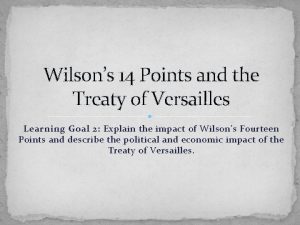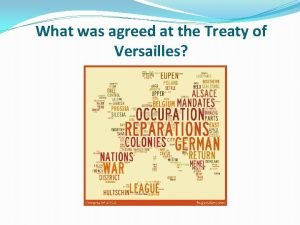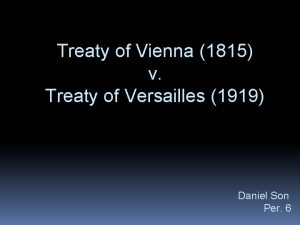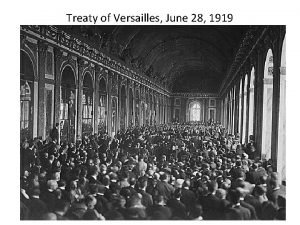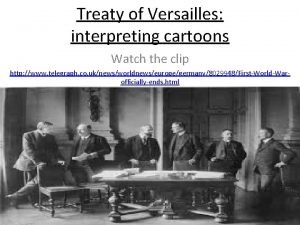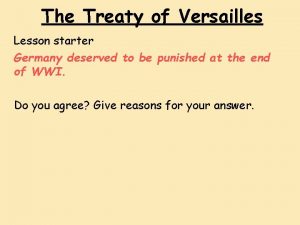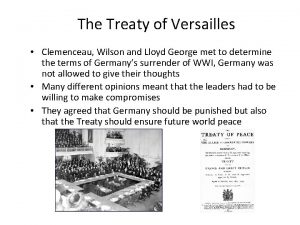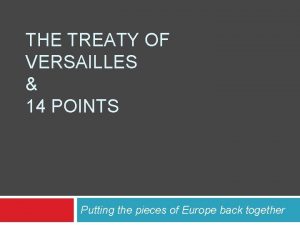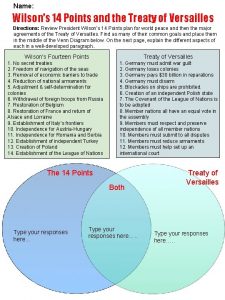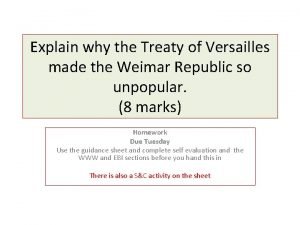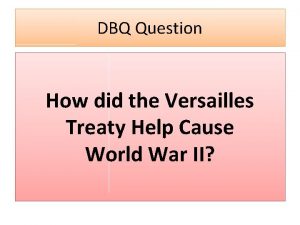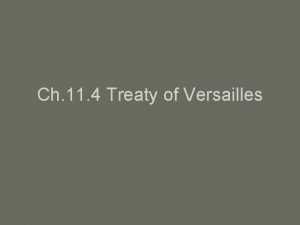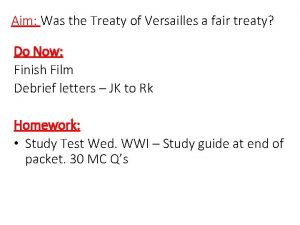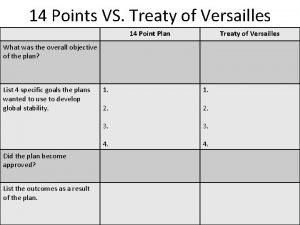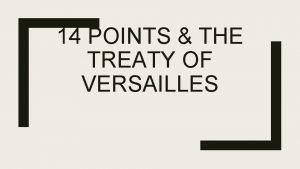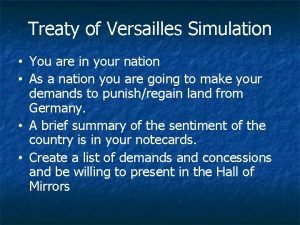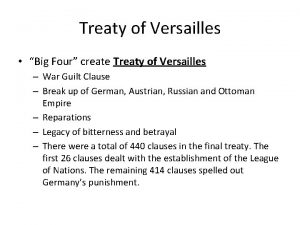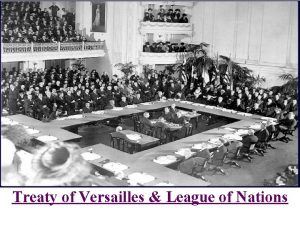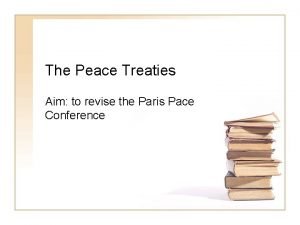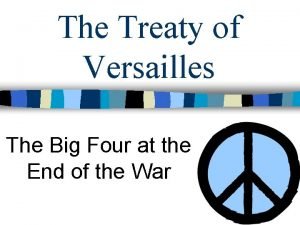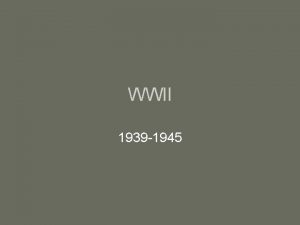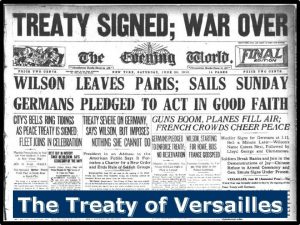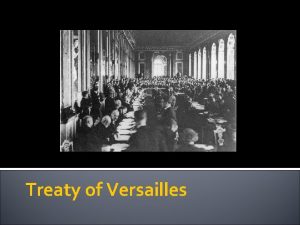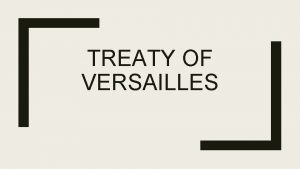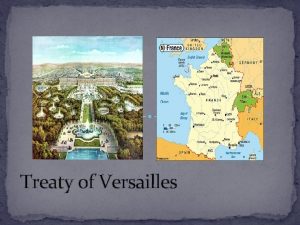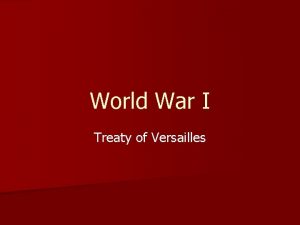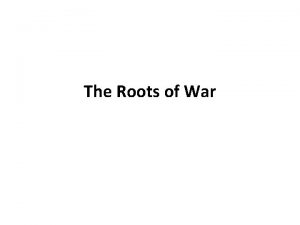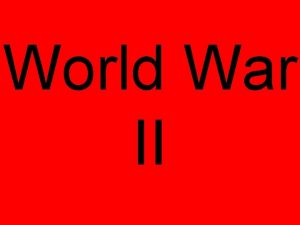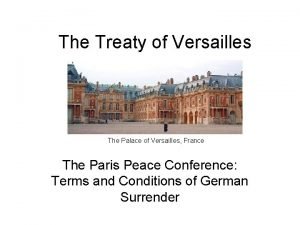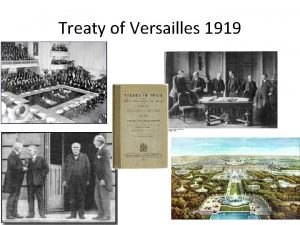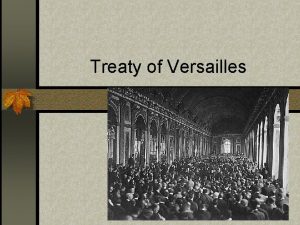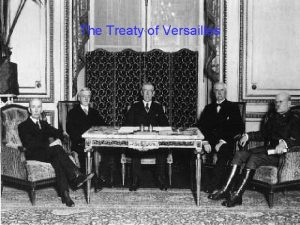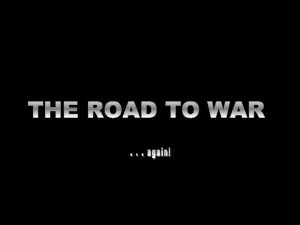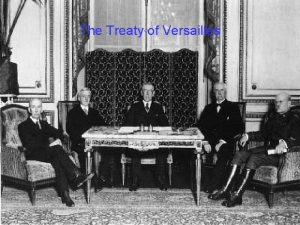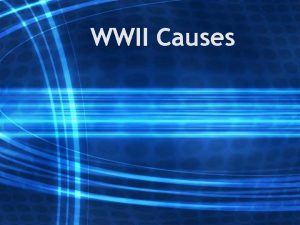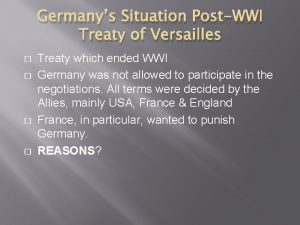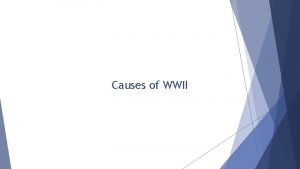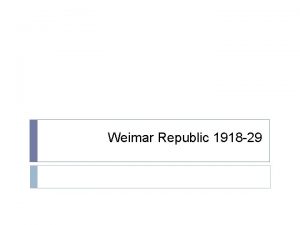World War II Treaty of Versailles 1918 The




























- Slides: 28

World War II

Treaty of Versailles - 1918 The Treaty of Versailles was written and signed by Germany and France at the end of World War I. The Paris Peace Conference was dominated by three men: ØFrench Prime Minster: Georges Clemenceau ØAmerican President: Woodrow Wilson ØBritish Prime Minster: David Lloyd George Clemenceau planned to make the Germans pay for the French lives and industries they had destroyed. The Peace Treaty stated that Germany was entirely to blame for the war and it’s terrible results. Germany had to pay up to 132 Billion Gold Marks to pay for damages they inflicted during the war.

THE ROAD TO WAR

March 12, 1938 - Germany occupies Austria. October 1, 1938 Nazi Troops occupy Sudetenland of the Czech Rep. March , 1939 The Nazi troops occupy other areas of Czechoslovakia

GERMANY FORMS ALLIANCES In May, 1939 Germany and Italy signed a Military Alliance known as the Pact of Steel: ØThe countries guaranteed to help defend each other in case of attack. j August, 1939 Germany and the Soviet Union signed the Nazi. Soviet Pact agreeing not to fight each other. Europe begins to Form Alliances (soon to become the “Allies”) against the Germans Britain – France – Holland

THE GERMAN OFFENSIVE

Hitler’s First Moves September 1, 1939 Nazi’s invade Poland on ØBritain and France declare war two days later. April 9, 1940 Nazi’s invade Denmark and Norway ØHitler wanted to invade Norway to establish Naval and Air bases and to secure the sea routes to Sweden.

The Madness Continues Fall Gelb (Case Yellow) May 10, 1940 Germans invade Belgium, Holland, and Luxemburg. May 14, 1940 Belgians were forced to retreat and the Dutch (Holland) surrendered on.

Operation Dynamo ØGermans began their drive into France ØAllies retreated to the Channel coast in England ØOn May 26, 1940 Operation, Dynamo, the evacuation of British, French and Belgium from the beaches of Dunkirk (France) began. Ø 10 days-340, 000 soldiers ferried across the English Channel to safety. ØParis fell on June 14, 1940 and an Armistice was signed eight days later.

Operation Sea Lion ØJuly 10, 1940 Luftwaffe (Germany’s Air Force) began to bomb towns and ships along England’s South Coast ØThe Battle of Britain had began. ØThe German’s aim was to seize control of British Air Space so that their ships could cross the Channel in safety. ØThe Luftwaffe made steady progress, but Hitler wanted quick results, so he identified a new target - London. ØHowever, the Luftwaffe was unable to secure a victory against the RAF (Britain’s Royal Air Force), so “Sea Lion” was called off on September 17. Germany’s new goal was to wipe out Military bases and factories. The Blitz lasted till May 1941 ØLuftwaffe had dropped 35, 000 tons of bombs on Britain and 19, 000 of them on London.


THE BATTLE OF THE ATLANTIC

The Battle of the Atlantic lasted from 1939 -1945 It was a contest between Britain (US later on) and Germany for the control of the Atlantic Sea Routes The Atlantic Ocean became a battle zone after the fall of Norway and France. ØNow that Germany took over Norway and France German shipping could operate from more ports over a wider area. U-Boats (submarines) attacked ships in “Wolf Pack” groups, and received support from German Aircraft. ØBritain fought back with more air support and better escort ships for convoys.

In March 1941 - Lend-Lease act was issued. ØArranged for the loan of money and equipment from the United States to it’s allies. ØLater on the US Navy began to escort shipping in the western Atlantic. ØOn the American east coast, during the first 6 months of 1942, the Germans sank 492 vessels. ØThe U-boats sank almost 300, 000 tons of Allied Shipping. German U-Boat An American Vessel


Italy did not declare war on the Allies until June 10, 1940 Before World War II Italy already had occupied several African Colonies including Libya. Ø In 1935 Mussolini (Italian Leader) occupied Abyssinia (Now Ethiopia) in northern Africa. Ø In 1940 the Italians invaded Egypt from Libya with a large number of troops (250, 000 Soldiers) However, Italians were forced to retreat after advancing just 50 miles (80 km) after the British Infantry and tanks stormed them into Libya. ØIn February of 1941 Hitler sent the Afrika Korps, under the command of Erwin Rommel, to the aid of the Italians. Rommel began a counter attack, forcing British to back toward Egypt.


ØOn October 23, 1942 General Montgomery and the British 8 th Army attacked Rommel at El Alamein (Egypt). ØRommel retreated 12 days later. Allies won their first major victory of the war against the Germans and Italians. ØNovember 8, 1942 Allies began Operation Torch, landing American and British troops in North Africa at Morocco and Algeria. ØBy 1943 they were fighting Rommel's retreating groups and on May 13 the Axis powers in Africa surrendered.

RUSSIA

OPERATION BARBAROSSA June 22, 1941 Germans start the invasion of Russia. Largest ground attack ever seen, involving 3, 500, 000 men. Germans were divided into 3 Groups. Army Group North Center South Headed for headed for Leningrad Moscow. Kiev.

1942 Attack On Stalingrad ØGerman attack on Stalingrad in southwestern Russia began August 19, 1942 ØSoviet counterstrike(Operation Uranus) tanks encircled Stalingrad and Luftwaffe could not fly in enough supplies. Ø 300, 000 Germans trapped in Stalingrad began to starve. ØNazi’s withdrawal January 31, 1943 ØThis was one of the bloodiest battles in the history of warfare

WAR IN THE PACIFIC (1941 -1943)

ØLate 19 th century Japan began a process of rapid modernization. Japan built up its empire, and started a period of aggressive expansion. Ø 1904 -1905 Japan defeated the Russians, forcing them out of Manchuria in northern China. Ø 1910 - Occupied Korea. Ø 1931 Japan invaded and occupied all of Manchuria. Ø 1933 left League of Nations Ø 1936 signed cooperation treaty with Germany

PEARL HARBOR ØAfter it’s success in China, Japan’s ambitions grew. ØU. S. President Franklin D. Roosevelt realized new problems were on the horizon and decided to stop Japans empire building by imposing economic sanctions ØJuly 1941, Japan annexed all of Indochina ØRoosevelt ended all trade with the Japanese and denied them access to oil money an possessions in the U. S ØDecember 7, 1941 - Japanese bombers attacked the American fleet at Pearl Harbor in Hawaii • 8 battle ships were sunk • More than 2, 400 sailors killed. ØDecember 8 U. S. declared war on Japan ØDecember 11 Germany and Italy declare war on the U. S.

AMERICA FIGHTS BACK 1945 - Iwo Jima and Okinawa were taken in early Spring by the Americans July 27 -President Truman demanded surrender or threatening to use the Atomic Bomb -Message was ignored August 6, 1945 - The first Atomic Bomb was dropped on Hiroshima(80, 000 were killed). The Japanese government did not surrender. August 9, 1945 - Second Atomic Bomb was dropped on Nagasaki; emperor Hirohito announces Japan’s surrender.

Before After Hiroshima

Before After Nagasaki

Adolf Hitler commits suicide- April 30, 1945 Berlin Surrenders to the Soviets on May 2, 1945 Germans signed a full unconditional surrender on May 7, 1945. VE Day(Allies victorious in Europe)- May 8, 1945 VJ Day(Allies victorious in Japan)- Aug. 15, 1945 68, 000 -75, 000 people were killed during World War II
 14 points vs treaty of versailles
14 points vs treaty of versailles The big three treaty of versailles
The big three treaty of versailles Treaty of versailles 1815
Treaty of versailles 1815 Article 231 of the treaty of versailles
Article 231 of the treaty of versailles Date
Date Treaty versailles terms
Treaty versailles terms Simplicissimus cartoon june 1919 analysis
Simplicissimus cartoon june 1919 analysis Whats the treaty of versailles
Whats the treaty of versailles Treaty of versailles lesson
Treaty of versailles lesson Trawl treaty of versailles
Trawl treaty of versailles 14 points vs treaty of versailles
14 points vs treaty of versailles 14 points vs treaty of versailles venn diagram
14 points vs treaty of versailles venn diagram Lamb acronym for the treaty of versailles
Lamb acronym for the treaty of versailles How did the versailles treaty help cause ww2
How did the versailles treaty help cause ww2 Time in germany
Time in germany Domino theory apush def
Domino theory apush def Wilson's fourteen points and the treaty of versailles
Wilson's fourteen points and the treaty of versailles Comparing the 14 points & treaty of versailles
Comparing the 14 points & treaty of versailles 14 points vs treaty of versailles
14 points vs treaty of versailles Treaty of versailles 14 points
Treaty of versailles 14 points Treaty of versailles
Treaty of versailles Treaty of versailles terms
Treaty of versailles terms The big 4 and the treaty of versailles interactive notebook
The big 4 and the treaty of versailles interactive notebook Treaty of versailles middle east
Treaty of versailles middle east The big four in the treaty of versailles
The big four in the treaty of versailles Treaty of versailles gargle
Treaty of versailles gargle The big 4 treaty of versailles
The big 4 treaty of versailles Plutonium
Plutonium What year was the treaty of versailles signed
What year was the treaty of versailles signed
